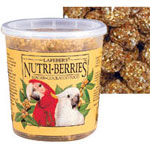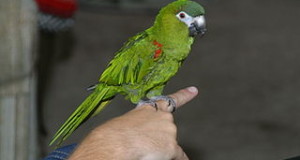When I first began work as a Bird Keeper at the Bronx Zoo, much of my time was spent cooking eggs and horsemeat, rearing and capturing insects, chopping produce and otherwise preparing the diets for thousands of birds (please see the article linked below for more information on feeding zoo birds). The introduction of nutritionally-sound pellets and chows for birds ranging from parrots to cassowaries forever changed how birds in both zoos and private homes are fed. A recent study of Parrot foods and nutrition has shed some new light on caring for these exotic pets.
But while it may be convenient to know exactly what nutrients our pets are consuming, many parrots look upon commercial pellets with disdain. And because pellets can be consumed far more quickly that seeds, parrots that do accept them are left with extra “free time” to fill; boredom becomes a problem unless additional enrichment opportunities are provided. Much of the research concerning standardized bird diets has focused on species typically kept in zoos. However, one recent study examined diets commonly fed to Amazon Parrots. Its results, I believe, have important implications for owners of all types of parrots.
Pellets vs. Seeds and Produce
A parrot nutrition study published in the Journal of Avian Medicine and Surgery (V. 26, N. 3) examined diets containing different proportions of commercial pellets, seeds and produce (fruits and vegetables). Amazon Parrots consuming the various diets were then evaluated as to their nutritional status. Levels of fat, calcium, sodium, iron and other nutrients, and calcium: phosphorus ratios, were analyzed.
Feeding Trials
The first diet contained less seed – 25% by weight – than most parrot owners use, along with 50% produce and 25% pellets. Yet even with this limited amount of seed, parrots consuming this diet were deficient in calcium, sodium and iron, and their fat intake was at an unhealthy level. The researchers also noted that the birds chose foods that exacerbated their nutritional deficiencies.
When seeds were reduced to 18% of the diet (60% pellets, 22% produce), the parrots still consumed too much fat, but levels of other nutrients, and their calcium: phosphorus ratios, were satisfactory.
A diet comprised of 75% pellets and 25% produce provided parrots with recommended levels of all nutrients. Based on these findings, it was recommended that produce, rather than seeds, be used to provide variety and foraging opportunities (shredding food, etc.).
Convincing Parrots to Accept Pellets
LaFeber Nutri-Berries combine pellets with molasses, fruits, vegetables, nuts and seeds, and are well- accepted by many parrots. Their consistency prevents most pets from picking out favorite items. Over time, additional pellets can be introduced, until they form the bulk of the diet. Please see this article for further information.
Behavioral Enrichment
Providing parrots with opportunities to explore, search for food, manipulate objects, interact with others and otherwise remain active and interested in their environments is critical to good health; indeed, one study has even established that enrichment opportunities can speed wound healing . Major zoos now require behavioral enrichment for nearly all animals, including reptiles and amphibians.
 Parrots fed largely upon pellets engage in less foraging behavior and food manipulation than do those on seed-based diets, increasing the likelihood that they will become bored. Providing commercial and homemade parrot toys is perhaps the simplest way to improve your pets’ quality of life. In recent years, a number of parrot toys have been specifically designed to foster exploratory and other beneficial behaviors. Often sold as “foraging toys” , they are well-worth considering. Please see the article linked below for further information, and be sure to post your own ideas as well.
Parrots fed largely upon pellets engage in less foraging behavior and food manipulation than do those on seed-based diets, increasing the likelihood that they will become bored. Providing commercial and homemade parrot toys is perhaps the simplest way to improve your pets’ quality of life. In recent years, a number of parrot toys have been specifically designed to foster exploratory and other beneficial behaviors. Often sold as “foraging toys” , they are well-worth considering. Please see the article linked below for further information, and be sure to post your own ideas as well.
Further Reading
Preparing Food for the Bronx Zoo’s Bird Collection
Enrichment: Adding Zest to Your Parrot’s Life
 That Bird Blog – Bird Care and History for Pet Birds
That Bird Blog – Bird Care and History for Pet Birds






Good article. Avi-Cakes are nutritionally similar to Nutri-Berries and have added benefits of being less expensive (easy to purchase in bulk) and chewy, which birds love. I use them as my birds’ base diet since they are 50% pellets and 50% seed. I also supplements with lots of fresh produce.
Great idea, thanks, Amy.
This suspiciously looks like an advertisement for Nutriberries to me. Who funded the research? Some birds hate nutriberries and throw them onto the floor of the cage. Just sayin!
Thank you for your interest. As mentioned in the article, the study was published in Journal of Avian Medicine and Surgery; the citation is there as well if needed. The journal’s editorial policy and reputation should negate any concerns re research funding, etc. However, that really is not a question here – please re-check my article when time permits…Nutriberries are not mentioned in connection with the Journal of Avian Medicine and Surgery study, but rather as a means of introducing pellets into the diet. Parrots are notoriously individualistic in their responses to new foods, of course..just about any food, including Nutriberries may be rejected or accepted. Over time and with a bit of manipulation and experimentation on the keeper’s part, Nutriberries have proven to be useful in many cases. best regards, Frank
Informative article…
Out of all the parrots species that I have kept over the years the only parrot species that I could get to regularly eat pellets was African Lovebirds.
Hello,
Thanks very much; I’ve found most lovebirds to be a bit more likely to try new foods than other parrots as well – maybe it’s in keeping with their often bold personalities! Best, Frank
When my African Grey eats avicakes or nutriberries she enjoys all of the seeds and wastes the pellets.
Frank do you have a link to the study itself? I’ve been trying to find it to flesh out this article a bit but am not finding it by scanning the journal.
Hello Linda,
That’s common, they are very good at selecting fav’s. Takes a great deal of time and effort, and a bit of hunger, to change them, as I’m sure you’ve seen. Best, Frank
Hello Megan,
It’s only available as an abstract online (authors may send a copy if you contact, and your library can likely obtain the actual article); this related article may be of interest: http://www.thefreelibrary.com/Nutritional+levels+of+diets+fed+to+captive+Amazon+parrots%3A+does…-a0327586315 Best, Frank
Thank you Frank! You are so quick. I appreciate it.
oh. That’s looking like a broken link…
My pleasure…try the link below, I just worked for me: http://www.thefreelibrary.com/Nutritional+levels+of+diets+fed+to+captive+Amazon+parrots%3A+does…-a0327586315 Let me know if you need anything, frank